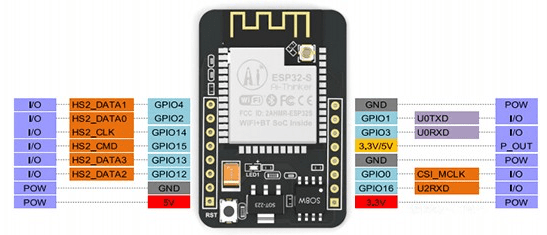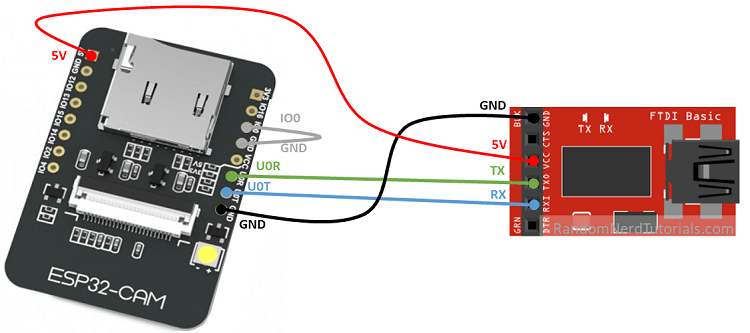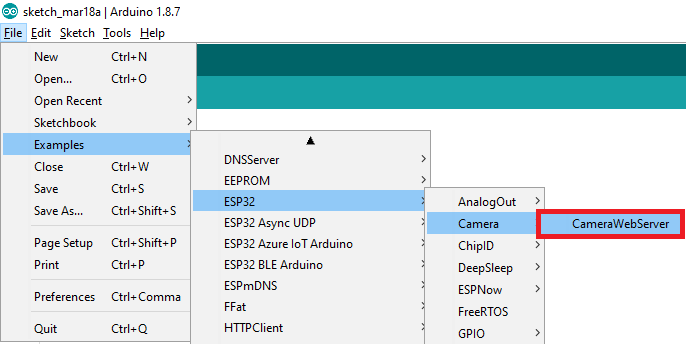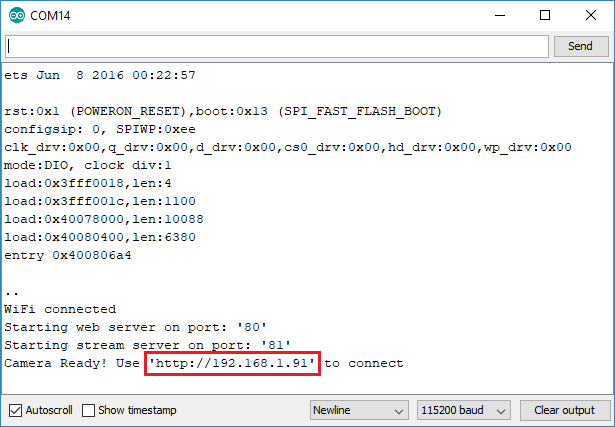ESP32 نسل جدید SoC های شرکت ESPressif می باشد که توانایی بالاتری نسبت به SoC های قبلی ESP8266 دارد . برد های توسعه زیادی بر پای ESP32 ساخته شده اند که هر کدام کاربرد خود را دارند . معمولا به دلیل پیچیدگی طراحی مدارات فرکانس بالا از ماژول های ESP32 به جای چیپ ESP32 استفاده می شود . این کار علاوه بر کاهش زمان طراحی هزینه ها را بسیار کاهش می دهد . اغلب برد های توسعه ESP32 دارای ماژول های WROOM یا WROVER هستند . یکی از برد های جذاب مبتنی بر ESP32 برد ESP-CAM می باشد . این برد شامل یک ماژول WROOM و یک دوربین OV2640 کوچک است . فرکانس کاری بالا ESP32 امکانراه اندازی دوربین ها را با سرعت زیاد و بدون دیلی فراهم می سازد . در پروژه های قبل آموزش راه اندازی ماژول OV7670 توسط برد آردوینو را شرح دادیم . در راه اندازی OV7670 با آردوینو برای هر بار دریافت کامل تصویر به زمانی تقریبا 5 ثانیه نیاز بود که امکان نمایش فیلم به صورت سریع را نداشت . اما ESP32 با فرکانس کاری 240MHz امکان دریاف سریع داده های دوربین را دارد . همچنین می توان به راحتی از طریق ارتباط وایفای تصاویر را مخابره کرد .
در تصویر زیر پین های برد ESP-CAM نشان داده شده است :
برد ESP-CAM شامل دوربین 2 مگاپیکسلی OV2640 ، یک LED جهت استفاده به عنوان فلش و همچنین یک اسلات SD است که می توان تصاویر را بر روی SD کارت ذخیره نمود .
برخلاف بیشتر برد های توسعه ESP32 ، در این برد از هیچ مبدل USB به TTL استفاده نشده است لذا برای پروگرام کردن آن باید از یک مبدل خارجی استفاده کنید . در تصویر زیر نحوه اتصال مبدل FT232 به برد ESP-CAM نشان داده شده است :
برای اینکه ماژول به حالت پروگرام برود باید IO0 را به زمین متصل کرد .
با اتصال ماژول به مبدل و اتصال ن به کامپیوتر ، در محیط آردوینو IDE وارد قسمت زیر شوید :
برای اینکه مثال های راه اندازی ESP-CAM در قسمت Examples آردوینو IDE موجود باشد باید برد ESP32 را قبلش نصب کرده باشید .
#include <esp_camera.h>
#include <esp_int_wdt.h>
#include <esp_task_wdt.h>
#include <WiFi.h>
#include <DNSServer.h>
#include "src/parsebytes.h"
/* This sketch is a extension/expansion/reork of the 'official' ESP32 Camera example
* sketch from Expressif:
* https://github.com/espressif/arduino-esp32/tree/master/libraries/ESP32/examples/Camera/CameraWebServer
*
* It is modified to allow control of Illumination LED Lamps's (present on some modules),
* greater feedback via a status LED, and the HTML contents are present in plain text
* for easy modification.
*
* A camera name can now be configured, and wifi details can be stored in an optional
* header file to allow easier updated of the repo.
*
* The web UI has had changes to add the lamp control, rotation, a standalone viewer,
* more feeedback, new controls and other tweaks and changes,
* note: Make sure that you have either selected ESP32 AI Thinker,
* or another board which has PSRAM enabled to use high resolution camera modes
*/
/*
* FOR NETWORK AND HARDWARE SETTINGS COPY OR RENAME 'myconfig.sample.h' TO 'myconfig.h' AND EDIT THAT.
*
* By default this sketch will assume an AI-THINKER ESP-CAM and create
* an accesspoint called "ESP32-CAM-CONNECT" (password: "InsecurePassword")
*
*/
// Primary config, or defaults.
#if __has_include("myconfig.h")
struct station { const char ssid[65]; const char password[65]; const bool dhcp;}; // do no edit
#include "myconfig.h"
#else
#warning "Using Defaults: Copy myconfig.sample.h to myconfig.h and edit that to use your own settings"
#define WIFI_AP_ENABLE
#define CAMERA_MODEL_AI_THINKER
struct station { const char ssid[65]; const char password[65]; const bool dhcp;}
stationList[] = {{"ESP32-CAM-CONNECT","InsecurePassword", true}};
#endif
// Upstream version string
#include "src/version.h"
// Pin Mappings
#include "camera_pins.h"
// Internal filesystem (SPIFFS)
// used for non-volatile camera settings and face DB store
#include "storage.h"
// Sketch Info
int sketchSize;
int sketchSpace;
String sketchMD5;
// Start with accesspoint mode disabled, wifi setup will activate it if
// no known networks are found, and WIFI_AP_ENABLE has been defined
bool accesspoint = false;
// IP address, Netmask and Gateway, populated when connected
IPAddress ip;
IPAddress net;
IPAddress gw;
// Declare external function from app_httpd.cpp
extern void startCameraServer(int hPort, int sPort);
// A Name for the Camera. (set in myconfig.h)
#if defined(CAM_NAME)
char myName[] = CAM_NAME;
#else
char myName[] = "ESP32 camera server";
#endif
// Ports for http and stream (override in myconfig.h)
#if defined(HTTP_PORT)
int httpPort = HTTP_PORT;
#else
int httpPort = 80;
#endif
#if defined(STREAM_PORT)
int streamPort = STREAM_PORT;
#else
int streamPort = 81;
#endif
#if !defined(WIFI_WATCHDOG)
#define WIFI_WATCHDOG 5000
#endif
// Number of known networks in stationList[]
int stationCount = sizeof(stationList)/sizeof(stationList[0]);
// If we have AP mode enabled, ignore first entry in the stationList[]
#if defined(WIFI_AP_ENABLE)
int firstStation = 1;
#else
int firstStation = 0;
#endif
// Select bvetween full and simple index as the default.
#if defined(DEFAULT_INDEX_FULL)
char default_index[] = "full";
#else
char default_index[] = "simple";
#endif
// DNS server
const byte DNS_PORT = 53;
DNSServer dnsServer;
bool captivePortal = false;
char apName[64] = "Undefined";
// The app and stream URLs
char httpURL[64] = {"Undefined"};
char streamURL[64] = {"Undefined"};
// Count number of active streams
int8_t streamCount = 0;
// This will be displayed to identify the firmware
char myVer[] PROGMEM = __DATE__ " @ " __TIME__;
// initial rotation
// can be set in myconfig.h
#if !defined(CAM_ROTATION)
#define CAM_ROTATION 0
#endif
int myRotation = CAM_ROTATION;
// Illumination LAMP/LED
#if defined(LAMP_DISABLE)
int lampVal = -1; // lamp is disabled in config
#elif defined(LAMP_PIN)
#if defined(LAMP_DEFAULT)
int lampVal = constrain(LAMP_DEFAULT,0,100); // initial lamp value, range 0-100
#else
int lampVal = 0; //default to off
#endif
#else
int lampVal = -1; // no lamp pin assigned
#endif
bool autoLamp = false; // Automatic lamp (auto on while camera running)
int lampChannel = 7; // a free PWM channel (some channels used by camera)
const int pwmfreq = 50000; // 50K pwm frequency
const int pwmresolution = 9; // duty cycle bit range
const int pwmMax = pow(2,pwmresolution)-1;
#if defined(NO_FS)
bool filesystem = false;
#else
bool filesystem = true;
#endif
#if defined(FACE_DETECTION)
int8_t detection_enabled = 1;
#if defined(FACE_RECOGNITION)
int8_t recognition_enabled = 1;
#else
int8_t recognition_enabled = 0;
#endif
#else
int8_t detection_enabled = 0;
int8_t recognition_enabled = 0;
#endif
// Critical error string; if set during init (camera hardware failure) it
// will be returned for all http requests
String critERR = "";
// Debug Data for stream and capture
#if defined(DEBUG_DEFAULT_ON)
bool debugData = true;
#else
bool debugData = false;
#endif
// Notification LED
void flashLED(int flashtime) {
#ifdef LED_PIN // If we have it; flash it.
digitalWrite(LED_PIN, LED_ON); // On at full power.
delay(flashtime); // delay
digitalWrite(LED_PIN, LED_OFF); // turn Off
#else
return; // No notifcation LED, do nothing, no delay
#endif
}
// Lamp Control
void setLamp(int newVal) {
if (newVal != -1) {
// Apply a logarithmic function to the scale.
int brightness = round((pow(2,(1+(newVal*0.02)))-2)/6*pwmMax);
ledcWrite(lampChannel, brightness);
Serial.print("Lamp: ");
Serial.print(newVal);
Serial.print("%, pwm = ");
Serial.println(brightness);
}
}
void WifiSetup() {
// Feedback that we are now attempting to connect
flashLED(300);
delay(100);
flashLED(300);
Serial.println("Starting WiFi");
Serial.print("Known external SSIDs: ");
if (stationCount > firstStation) {
for (int i=firstStation; i < stationCount; i++) Serial.printf(" '%s'", stationList[i].ssid);
} else {
Serial.print("None");
}
Serial.println();
byte mac[6] = {0,0,0,0,0,0};
WiFi.macAddress(mac);
Serial.printf("MAC address: %02X:%02X:%02X:%02X:%02X:%02X\n", mac[0], mac[1], mac[2], mac[3], mac[4], mac[5]);
int bestStation = -1;
long bestRSSI = -1024;
char bestSSID[65] = "";
uint8_t bestBSSID[6];
if (stationCount > firstStation) {
// We have a list to scan
Serial.printf("Scanning local Wifi Networks\n");
int stationsFound = WiFi.scanNetworks();
Serial.printf("%i networks found\n", stationsFound);
if (stationsFound > 0) {
for (int i = 0; i < stationsFound; ++i) {
// Print SSID and RSSI for each network found
String thisSSID = WiFi.SSID(i);
int thisRSSI = WiFi.RSSI(i);
String thisBSSID = WiFi.BSSIDstr(i);
Serial.printf("%3i : [%s] %s (%i)", i + 1, thisBSSID.c_str(), thisSSID.c_str(), thisRSSI);
// Scan our list of known external stations
for (int sta = firstStation; sta < stationCount; sta++) {
if ((strcmp(stationList[sta].ssid, thisSSID.c_str()) == 0) ||
(strcmp(stationList[sta].ssid, thisBSSID.c_str()) == 0)) {
Serial.print(" - Known!");
// Chose the strongest RSSI seen
if (thisRSSI > bestRSSI) {
bestStation = sta;
strncpy(bestSSID, thisSSID.c_str(), 64);
// Convert char bssid[] to a byte array
parseBytes(thisBSSID.c_str(), ':', bestBSSID, 6, 16);
bestRSSI = thisRSSI;
}
}
}
Serial.println();
}
}
} else {
// No list to scan, therefore we are an accesspoint
accesspoint = true;
}
if (bestStation == -1) {
if (!accesspoint) {
#if defined(WIFI_AP_ENABLE)
Serial.println("No known networks found, entering AccessPoint fallback mode");
accesspoint = true;
#else
Serial.println("No known networks found");
#endif
} else {
Serial.println("AccessPoint mode selected in config");
}
} else {
Serial.printf("Connecting to Wifi Network %d: [%02X:%02X:%02X:%02X:%02X:%02X] %s \n",
bestStation, bestBSSID[0], bestBSSID[1], bestBSSID[2], bestBSSID[3],
bestBSSID[4], bestBSSID[5], bestSSID);
// Apply static settings if necesscary
if (stationList[bestStation].dhcp == false) {
#if defined(ST_IP)
Serial.println("Applying static IP settings");
#if !defined (ST_GATEWAY) || !defined (ST_NETMASK)
#error "You must supply both Gateway and NetMask when specifying a static IP address"
#endif
IPAddress staticIP(ST_IP);
IPAddress gateway(ST_GATEWAY);
IPAddress subnet(ST_NETMASK);
#if !defined(ST_DNS1)
WiFi.config(staticIP, gateway, subnet);
#else
IPAddress dns1(ST_DNS1);
#if !defined(ST_DNS2)
WiFi.config(staticIP, gateway, subnet, dns1);
#else
IPAddress dns2(ST_DNS2);
WiFi.config(staticIP, gateway, subnet, dns1, dns2);
#endif
#endif
#else
Serial.println("Static IP settings requested but not defined in config, falling back to dhcp");
#endif
}
#if defined(HOSTNAME)
WiFi.setHostname(HOSTNAME);
#endif
// Initiate network connection request (3rd argument, channel = 0 is 'auto')
WiFi.begin(bestSSID, stationList[bestStation].password, 0, bestBSSID);
// Wait to connect, or timeout
unsigned long start = millis();
while ((millis() - start <= WIFI_WATCHDOG) && (WiFi.status() != WL_CONNECTED)) {
delay(500);
Serial.print('.');
}
// If we have connected, inform user
if (WiFi.status() == WL_CONNECTED) {
Serial.println("Client connection succeeded");
accesspoint = false;
// Note IP details
ip = WiFi.localIP();
net = WiFi.subnetMask();
gw = WiFi.gatewayIP();
Serial.printf("IP address: %d.%d.%d.%d\n",ip[0],ip[1],ip[2],ip[3]);
Serial.printf("Netmask : %d.%d.%d.%d\n",net[0],net[1],net[2],net[3]);
Serial.printf("Gateway : %d.%d.%d.%d\n",gw[0],gw[1],gw[2],gw[3]);
// Flash the LED to show we are connected
for (int i = 0; i < 5; i++) {
flashLED(50);
delay(150);
}
} else {
Serial.println("Client connection Failed");
WiFi.disconnect(); // (resets the WiFi scan)
}
}
if (accesspoint && (WiFi.status() != WL_CONNECTED)) {
// The accesspoint has been enabled, and we have not connected to any existing networks
#if defined(AP_CHAN)
Serial.println("Setting up Fixed Channel AccessPoint");
Serial.print(" SSID : ");
Serial.println(stationList[0].ssid);
Serial.print(" Password : ");
Serial.println(stationList[0].password);
Serial.print(" Channel : ");
Serial.println(AP_CHAN);
WiFi.softAP(stationList[0].ssid, stationList[0].password, AP_CHAN);
# else
Serial.println("Setting up AccessPoint");
Serial.print(" SSID : ");
Serial.println(stationList[0].ssid);
Serial.print(" Password : ");
Serial.println(stationList[0].password);
WiFi.softAP(stationList[0].ssid, stationList[0].password);
#endif
#if defined(AP_ADDRESS)
// User has specified the AP details; apply them after a short delay
// (https://github.com/espressif/arduino-esp32/issues/985#issuecomment-359157428)
delay(100);
IPAddress local_IP(AP_ADDRESS);
IPAddress gateway(AP_ADDRESS);
IPAddress subnet(255,255,255,0);
WiFi.softAPConfig(local_IP, gateway, subnet);
#endif
// Note AP details
ip = WiFi.softAPIP();
net = WiFi.subnetMask();
gw = WiFi.gatewayIP();
strcpy(apName, stationList[0].ssid);
Serial.printf("IP address: %d.%d.%d.%d\n",ip[0],ip[1],ip[2],ip[3]);
// Flash the LED to show we are connected
for (int i = 0; i < 5; i++) {
flashLED(150);
delay(50);
}
// Start the DNS captive portal if requested
if (stationList[0].dhcp == true) {
Serial.println("Starting Captive Portal");
dnsServer.start(DNS_PORT, "*", ip);
captivePortal = true;
}
}
}
void setup() {
// This might reduce boot loops caused by camera init failures when soft rebooting
// See, for instance, https://esp32.com/viewtopic.php?t=3152
Serial.begin(115200);
Serial.setDebugOutput(true);
Serial.println();
Serial.println("====");
Serial.print("esp32-cam-webserver: ");
Serial.println(myName);
Serial.print("Code Built: ");
Serial.println(myVer);
Serial.print("Base Release: ");
Serial.println(baseVersion);
if (stationCount == 0) {
Serial.println("\nFatal Error; Halting");
Serial.println("No wifi ssid details have been configured; we cannot connect to WiFi or start our own AccessPoint");
while (true) delay(1000);
}
#if defined(LED_PIN) // If we have a notification LED, set it to output
pinMode(LED_PIN, OUTPUT);
digitalWrite(LED_PIN, LED_ON);
#endif
// Create camera config structure; and populate with hardware and other defaults
camera_config_t config;
config.ledc_channel = LEDC_CHANNEL_0;
config.ledc_timer = LEDC_TIMER_0;
config.pin_d0 = Y2_GPIO_NUM;
config.pin_d1 = Y3_GPIO_NUM;
config.pin_d2 = Y4_GPIO_NUM;
config.pin_d3 = Y5_GPIO_NUM;
config.pin_d4 = Y6_GPIO_NUM;
config.pin_d5 = Y7_GPIO_NUM;
config.pin_d6 = Y8_GPIO_NUM;
config.pin_d7 = Y9_GPIO_NUM;
config.pin_xclk = XCLK_GPIO_NUM;
config.pin_pclk = PCLK_GPIO_NUM;
config.pin_vsync = VSYNC_GPIO_NUM;
config.pin_href = HREF_GPIO_NUM;
config.pin_sscb_sda = SIOD_GPIO_NUM;
config.pin_sscb_scl = SIOC_GPIO_NUM;
config.pin_pwdn = PWDN_GPIO_NUM;
config.pin_reset = RESET_GPIO_NUM;
config.xclk_freq_hz = 20000000;
config.pixel_format = PIXFORMAT_JPEG;
//init with highest supported specs to pre-allocate large buffers
if(psramFound()){
config.frame_size = FRAMESIZE_UXGA;
config.jpeg_quality = 10;
config.fb_count = 2;
} else {
config.frame_size = FRAMESIZE_SVGA;
config.jpeg_quality = 12;
config.fb_count = 1;
}
#if defined(CAMERA_MODEL_ESP_EYE)
pinMode(13, INPUT_PULLUP);
pinMode(14, INPUT_PULLUP);
#endif
// camera init
esp_err_t err = esp_camera_init(&config);
if (err != ESP_OK) {
delay(100); // need a delay here or the next serial o/p gets missed
Serial.printf("\n\nCRITICAL FAILURE: Camera sensor failed to initialise.\n\n");
Serial.printf("A full (hard, power off/on) reboot will probably be needed to recover from this.\n");
Serial.printf("Meanwhile; this unit will reboot in 1 minute since these errors sometime clear automatically\n");
// Reset the I2C bus.. may help when rebooting.
periph_module_disable(PERIPH_I2C0_MODULE); // try to shut I2C down properly in case that is the problem
periph_module_disable(PERIPH_I2C1_MODULE);
periph_module_reset(PERIPH_I2C0_MODULE);
periph_module_reset(PERIPH_I2C1_MODULE);
// And set the error text for the UI
critERR = "<h1>Error!</h1><hr><p>Camera module failed to initialise!</p><p>Please reset (power off/on) the camera.</p>";
critERR += "<p>We will continue to reboot once per minute since this error sometimes clears automatically.</p>";
// Start a 60 second watchdog timer
esp_task_wdt_init(60,true);
esp_task_wdt_add(NULL);
} else {
Serial.println("Camera init succeeded");
// Get a reference to the sensor
sensor_t * s = esp_camera_sensor_get();
// Dump camera module, warn for unsupported modules.
switch (s->id.PID) {
case OV9650_PID: Serial.println("WARNING: OV9650 camera module is not properly supported, will fallback to OV2640 operation"); break;
case OV7725_PID: Serial.println("WARNING: OV7725 camera module is not properly supported, will fallback to OV2640 operation"); break;
case OV2640_PID: Serial.println("OV2640 camera module detected"); break;
case OV3660_PID: Serial.println("OV3660 camera module detected"); break;
default: Serial.println("WARNING: Camera module is unknown and not properly supported, will fallback to OV2640 operation");
}
// OV3660 initial sensors are flipped vertically and colors are a bit saturated
if (s->id.PID == OV3660_PID) {
s->set_vflip(s, 1); //flip it back
s->set_brightness(s, 1); //up the blightness just a bit
s->set_saturation(s, -2); //lower the saturation
}
// M5 Stack Wide has special needs
#if defined(CAMERA_MODEL_M5STACK_WIDE)
s->set_vflip(s, 1);
s->set_hmirror(s, 1);
#endif
// Config can override mirror and flip
#if defined(H_MIRROR)
s->set_hmirror(s, H_MIRROR);
#endif
#if defined(V_FLIP)
s->set_vflip(s, V_FLIP);
#endif
// set initial frame rate
#if defined(DEFAULT_RESOLUTION)
s->set_framesize(s, DEFAULT_RESOLUTION);
#else
s->set_framesize(s, FRAMESIZE_SVGA);
#endif
/*
* Add any other defaults you want to apply at startup here:
* uncomment the line and set the value as desired (see the comments)
*
* these are defined in the esp headers here:
* https://github.com/espressif/esp32-camera/blob/master/driver/include/sensor.h#L149
*/
//s->set_framesize(s, FRAMESIZE_SVGA); // FRAMESIZE_[QQVGA|HQVGA|QVGA|CIF|VGA|SVGA|XGA|SXGA|UXGA|QXGA(ov3660)]);
//s->set_quality(s, val); // 10 to 63
//s->set_brightness(s, 0); // -2 to 2
//s->set_contrast(s, 0); // -2 to 2
//s->set_saturation(s, 0); // -2 to 2
//s->set_special_effect(s, 0); // 0 to 6 (0 - No Effect, 1 - Negative, 2 - Grayscale, 3 - Red Tint, 4 - Green Tint, 5 - Blue Tint, 6 - Sepia)
//s->set_whitebal(s, 1); // aka 'awb' in the UI; 0 = disable , 1 = enable
//s->set_awb_gain(s, 1); // 0 = disable , 1 = enable
//s->set_wb_mode(s, 0); // 0 to 4 - if awb_gain enabled (0 - Auto, 1 - Sunny, 2 - Cloudy, 3 - Office, 4 - Home)
//s->set_exposure_ctrl(s, 1); // 0 = disable , 1 = enable
//s->set_aec2(s, 0); // 0 = disable , 1 = enable
//s->set_ae_level(s, 0); // -2 to 2
//s->set_aec_value(s, 300); // 0 to 1200
//s->set_gain_ctrl(s, 1); // 0 = disable , 1 = enable
//s->set_agc_gain(s, 0); // 0 to 30
//s->set_gainceiling(s, (gainceiling_t)0); // 0 to 6
//s->set_bpc(s, 0); // 0 = disable , 1 = enable
//s->set_wpc(s, 1); // 0 = disable , 1 = enable
//s->set_raw_gma(s, 1); // 0 = disable , 1 = enable
//s->set_lenc(s, 1); // 0 = disable , 1 = enable
//s->set_hmirror(s, 0); // 0 = disable , 1 = enable
//s->set_vflip(s, 0); // 0 = disable , 1 = enable
//s->set_dcw(s, 1); // 0 = disable , 1 = enable
//s->set_colorbar(s, 0); // 0 = disable , 1 = enable
// We now have camera with default init
// check for saved preferences and apply them
if (filesystem) {
filesystemStart();
loadPrefs(SPIFFS);
loadFaceDB(SPIFFS);
} else {
Serial.println("No Internal Filesystem, cannot save preferences or face DB");
}
}
/*
* Camera setup complete; initialise the rest of the hardware.
*/
// Initialise and set the lamp
if (lampVal != -1) {
ledcSetup(lampChannel, pwmfreq, pwmresolution); // configure LED PWM channel
if (autoLamp) setLamp(0); // set default value
else setLamp(lampVal);
ledcAttachPin(LAMP_PIN, lampChannel); // attach the GPIO pin to the channel
} else {
Serial.println("No lamp, or lamp disabled in config");
}
// Having got this far; start Wifi and loop until we are connected or have started an AccessPoint
while ((WiFi.status() != WL_CONNECTED) && !accesspoint) {
WifiSetup();
delay(1000);
}
// Now we have a network we can start the two http handlers for the UI and Stream.
startCameraServer(httpPort, streamPort);
#if defined(URL_HOSTNAME)
if (httpPort != 80) {
sprintf(httpURL, "http://%s:%d/", URL_HOSTNAME, httpPort);
} else {
sprintf(httpURL, "http://%s/", URL_HOSTNAME);
}
sprintf(streamURL, "http://%s:%d/", URL_HOSTNAME, streamPort);
#else
if (httpPort != 80) {
sprintf(httpURL, "http://%d.%d.%d.%d:%d/", ip[0], ip[1], ip[2], ip[3], httpPort);
} else {
sprintf(httpURL, "http://%d.%d.%d.%d/", ip[0], ip[1], ip[2], ip[3]);
}
sprintf(streamURL, "http://%d.%d.%d.%d:%d/", ip[0], ip[1], ip[2], ip[3], streamPort);
#endif
if (critERR.length() == 0) {
Serial.printf("\nCamera Ready!\nUse '%s' to connect\n", httpURL);
Serial.printf("Stream viewer available at '%sview'\n", streamURL);
Serial.printf("Raw stream URL is '%s'\n", streamURL);
if (debugData) Serial.println("Camera debug data is enabled (send any char to disable)");
else Serial.println("Camera debug data is disabled (send any char to enable)");
} else {
Serial.printf("\nCamera unavailable due to initialisation errors.\n\n");
}
// Used when dumping status; these are slow functions, so just do them once during startup
sketchSize = ESP.getSketchSize();
sketchSpace = ESP.getFreeSketchSpace();
sketchMD5 = ESP.getSketchMD5();
}
void loop() {
/*
* Just loop forever, reconnecting Wifi As necesscary in client mode
* The stream and URI handler processes initiated by the startCameraServer() call at the
* end of setup() will handle the camera and UI processing from now on.
*/
if (accesspoint) {
// Accespoint is permanently up, so just loop, servicing the captive portal as needed
unsigned long start = millis();
while (millis() - start < WIFI_WATCHDOG ) {
delay(100);
if (captivePortal) dnsServer.processNextRequest();
}
} else {
// client mode can fail; so reconnect as appropriate
static bool warned = false;
if (WiFi.status() == WL_CONNECTED) {
// We are connected, wait a bit and re-check
if (warned) {
// Tell the user if we have just reconnected
Serial.println("WiFi reconnected");
warned = false;
}
// loop here for WIFI_WATCHDOG, turning debugData true/false depending on serial input..
unsigned long start = millis();
while (millis() - start < WIFI_WATCHDOG ) {
delay(100);
if (Serial.available()) {
// Toggle debug output on serial input
if (debugData) {
debugData = false;
Serial.println("Camera debug data is disabled (send any char to enable)");
} else {
debugData = true;
Serial.println("Camera debug data is enabled (send any char to disable)");
}
}
while (Serial.available()) Serial.read(); // chomp the buffer
}
} else {
// disconnected; attempt to reconnect
if (!warned) {
// Tell the user if we just disconnected
WiFi.disconnect(); // ensures disconnect is complete, wifi scan cleared
Serial.println("WiFi disconnected, retrying");
warned = true;
}
WifiSetup();
}
}
}
قبل از آپلود کد های فوق بر روی برد خود لازم است قسمت هایی را تغغیر دهید . ابتدا قسمت انتخاب مدل برد را برحسب نوع برد خود تغییر دهید (از حالت کامنت خارج کنید ):
// Select camera model //#define CAMERA_MODEL_WROVER_KIT //#define CAMERA_MODEL_ESP_EYE //#define CAMERA_MODEL_M5STACK_PSRAM //#define CAMERA_MODEL_M5STACK_WIDE //#define CAMERA_MODEL_AI_THINKER
در قسمت SSID و Password ، رمز و نام وایفای مودم را وارد کنید :
const char* ssid = "REPLACE_WITH_YOUR_SSID"; const char* password = "REPLACE_WITH_YOUR_PASSWORD";
پس از آپلود کردن برنامه فوق ، وارد قسمت Serial monitor آردوینو شوید . آدرس IP که چاپ می شود را در مرورگر خود باز کنید :
در نهایت تصویری همانند زیر نشان داده خواهد شد :
منبع : https://randomnerdtutorials.com/esp32-cam-video-streaming-face-recognition-arduino-ide/





